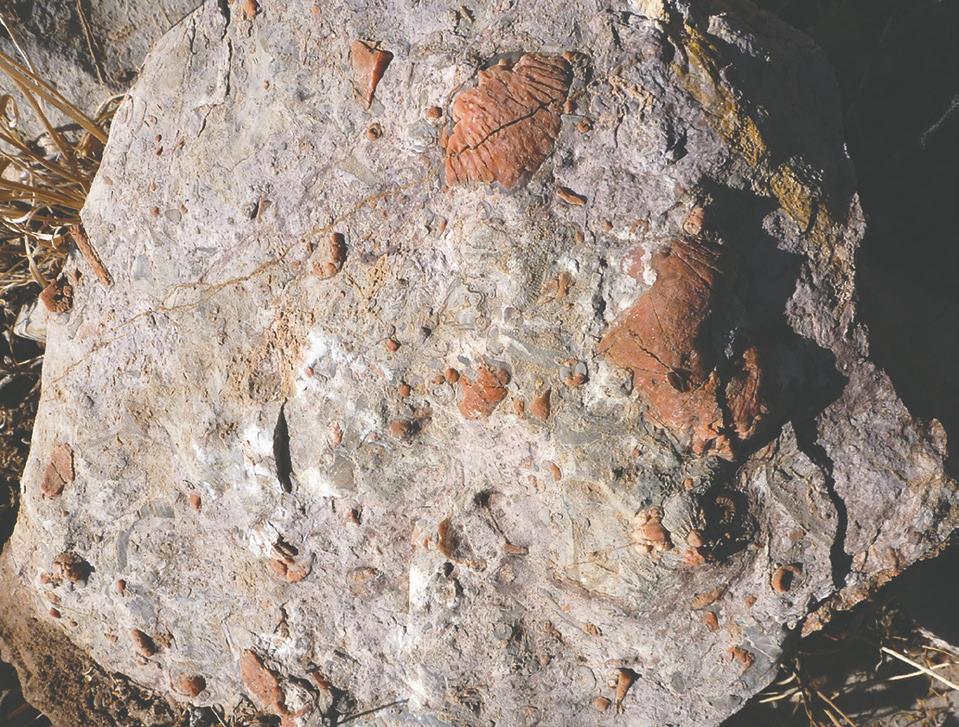February 2021
Time Travel Trails #4
7
Aftermath of the Cambrian Explosion BY JOHN TRIMBLE
Our last time travel trail took us up Gerald Wash to Dago Springs, where we visited with a trace fossil in the Mescal Limestone. This time travel trail will take us to another limestone, but well after the time of the Precambrian tube worm last visited. We are going to a time when life has exploded into nearly all the types (phylum) that live today. It has moved from marine life only and onto the land, which is now covered with forests where giant insects roam that will create the coal that gave this age its name, the Carboniferous age.
Round Mountain from high end start of East Trail Loop Yes, Nellie, we will take just a few steps down this East Trail and look for the grey rocks.
Earth Timeline with Life Forms Our trip starts at a well-known local hiking destination, Round Mountain Park, which is located at the end of South St. from Highway 60. Round Mountain is home to five different hiking loops. Our time travel trail is on the East Loop. This will be to the right as you enter the park. Note that the parking lot has been cut into the Gila Conglomerate, which is the rock formation that surrounds Globe City. The Gila Conglomerate is formed from an accumulation of debris from all the older rock types in the region. These fragments were deposited in a broad valley by transient floods and intermittent streams, with some fragments rounded by tumbling during transport. So just stepping out of the car, we have travelled back to the early Pleistocene, which is the age of the mammal.
Limestone float showing a mixture of crinoids & brachiopods.
Microscopic views of Crinoid View is along a horizontal section of a crinoid stem with an end view of a crinoid segment just to its right.
East Trail Round Mountain Park Starting down the East Loop, we cross a small fault block of Tertiary dacite, a fine-grained igneous rocks, and then into an extensive fault block of the Cambrian age formation, the Troy Quartzite. This would be the time of the Cambrian explosion of life, but the Troy Quartzite might have been formed from a barren desert, as not a sign of life can be found in it, just a few thin bands with pebbles. This area is faulted up and down, which makes our time travel erratic as we cross faults, but is great for injecting mineralizing fluids. So be sure to look for iron stains (various shades of red and purple) and manganese staining (black), which is how the old prospectors located ore zones – they called it “iron cap”. You can prowl around just north of Round Mountain and explore along the Albert Lea vein, which contains silver, lead, manganese and vanadinite coating. But putting our prospecting aside, we are still looking for signs of life, so we hunt for a marine sedimentary rock and are just passing through the Troy Quartzite and bits of dacite igneous blocks on our way up the trail and over the pass.
I started counting my steps to the limestone from the East Trail sign. I could see the grey rocks (limestone) on the hill below as it outcropped and trended off to the northeast. As I went down the trail after about 10 paces I noticed that I had crossed another major fault and was now standing on limestone outcrops, with just a coating of quartzite float rocks weathering down from Round Mountain obscuring them. Float is what a geologist calls a loose rock that has weathered loose from its formation and washed downhill, floated, which means you can’t trust it to tell what formation you are standing on.
Microscopic View of Fossil Hash View shows crinoids, fusilids, arthropod jaw (black object with a tail- like extension), brachiopod fragments and sponge spiricles. As we stepped across the fault zone, we traveled into deep time on the east trail from Round Mountain. We are now in the Mississippian Age, standing on sediments from a warm, shallow sea. Life is abundant but not as mellow as when the tube worms were grazing on algae at our last trail. Arthropods, corals, bryozoa, crinoids, and mollusks flourish in the warm, shallow seas. Echinoderms, especially Crinoids, were extremely numerous. It is still the time of the filter feeders, but now they are armored to protect themselves from roaming predator arthropods, fishes and cephalopods. The trilobite has almost died out, and we see none of them here, but numerous predators roam this sea.
Are we there yet Dad? Yes, Nellie, we are now within a few steps of the Escabrosa Limestone, which has lots and lots of fossils.
Predator of the Sky
Sweetheart of a Fossil Several brachiopods with different angles exposed. Heart shape is edge view of both valves of a brachiopod. Possibly a variety of Spiriferidea.
It is important to remember that this outcrop is part of a park that we all share, even the hawk giving us a watchful eye. So please take only pictures and leave only footprints. There are lots of outcrops of the Escabrosa in Gila County on Federal land, where it is legal to collect invertebrate fossils, and we will visit this Paleozoic time on another time travel trail again as we continue our hunt for a quality specimen of the solitary coral Rugosa, who has been known to frequent these parts.
Buy • Sell • Trade Firearms Class 3 Dealer
Optics and Accessories
AZ Game & Fish Dealer
(928) 402-0000 NEW LOCATION! 3523 US 60 • Miami, AZ 85539 www.dominionfirearmsllc.com







